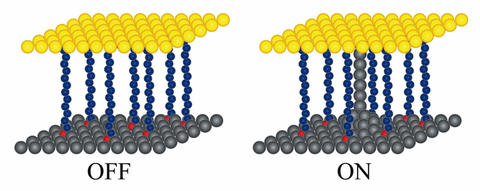
Silver nanoswitch: when the voltage between a gold conductor (top) and silver conductor (bottom) exceeds a critical point, silver ions rapidly assemble like a lightning strike to bridge the gap through a organic molecule monolayer.
NIST scientists and engineers have been recognized as inventors in a variety of research areas, including the biosciences, building and fire research, materials science and manufacturing. This past year, NIST was awarded nine patents for original technologies and methods.
The following patents were awarded in 2012:
- Harvesting of Processed Carbon Nanotubes, U.S. Patent 8,251,225, invented by John Marino and Gary Giulian*. A method of harvesting carbon nanotubes (CNTs) that separates them from their metallic catalysts, removes their amorphous carbon shells and shortens them. This method is more robust and scalable, while being much less destructive to the CNTs, than the existing harvesting techniques used to collect pure populations of the tubes for large-scale applications.
- Fabrication Method of Topographically Modulated Microstructures Using Pattern Homogenization with UV Light, U.S. Patent 8,236,480, invented by Laurie Locascio, Francisco Javier Atencia-Fernandez, Susan Barnes* and Jack Douglas. A method for microfabrication of a microfluidic device with submillimeter three-dimensional relief structures that requires a single photolithographic step and allows for microstructures over large areas (centimeters) with topographic modulation of features smaller than 100 micrometers. The method generates topography that is useful in a broad range of microfluidic applications.
- Recirculating Temperature Wave Focusing Chromatography, U.S. Patent 8,226,825, invented by David Ross. A new way to separate mixtures for analysis that leads to higher resolution measurements and lower detection limits.
- Method and Device for Generating Diffusive Gradients in a Microfluidic Chamber, U.S. Patent 8,216,526, invented by Laurie Locascio and Francisco Javier Atencia-Fernandez. A system for performing centrifugal analysis on different components of a small sample volume of working fluid that can also be used to evaluate how bacteria or other microorganisms react or respond to chemicals in the absence of convective flow.
- Novel, Anti-Bacterial Monomers, Oligomers and Polymers for Dental and Biomedical Applications, U.S. Patent 8,217,081, invented by Joseph Antonucci. Bio-affecting compositions that may be used with dental resins of various types to reduce, limit or eliminate the propagation of bacteria where the resins typically shrink away from the tooth, thereby reducing tooth decay.
- Dielectric Resonator Thermometer and a Method of Using the Same, U.S. Patent 8,123,399, invented by Michael Moldover, Dean Ripple and Gregory Strouse. A temperature measuring method based on a dielectric sensor that is considered a cost-effective industrial thermometer with improved stability, resistance to mechanical shock, and greater certainty in temperature measurements than commonly used platinum resistance thermometers.
- Process and Apparatus for the Measurement of Thermal Radiation Using Regular Glass Optics and Short-Wave Infrared Detectors, U.S. Patent 8,119,987, invented by George Eppeldauer* and Howard Yoon. An infrared measurement apparatus and method to detect and view ambient-temperature objects using shortwave infrared detectors without the need for cryogenic cooling of quantum detector materials and/or thermal detectors such as thermopiles, pyroelectrics or bolometers.
- Method for NRB-Free Nonlinear Vibrational Spectroscopy and Microscopy, U.S. Patent 8,120,772, invented by Marcus Cicerone and Young Jong Lee*. A method for increasing sensitivity and signal-to-noise ratio in broadband coherent microscopy used widely for noninvasive, chemical imaging of biological and polymeric samples.
- Self-Assembled Monolayer Based Silver Switches, U.S. Patent 8,101,942, invented by Jeremy Beebe* and James Kushmerick. A two-state switching device based on two electrodes separated by a self-assembled monolayer. The device is easy to fabricate, smaller than currently available devices, and could be incorporated into a variety of device geometries.
NIST encourages patent protection on its inventions when a patent would increase the potential for current or future commercialization or use of the technology, have a positive impact on a new field of science or technology and/or the visibility and vitality of NIST, or further the goals of collaborative agreements.
Although patents are issued in the name of the inventor, the rights to inventions resulting from government work belong to the government. NIST's Office of Technology Partnerships is responsible for negotiating the licensing of patented NIST technology. Learn more about licensing NIST technology.
* Not a member of the NIST staff.

